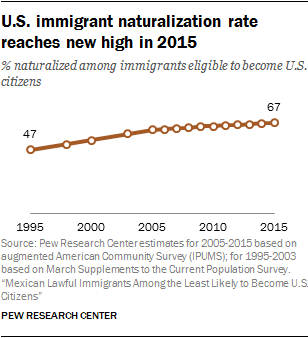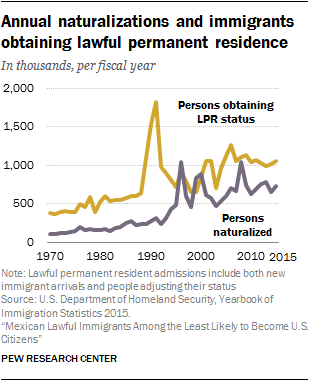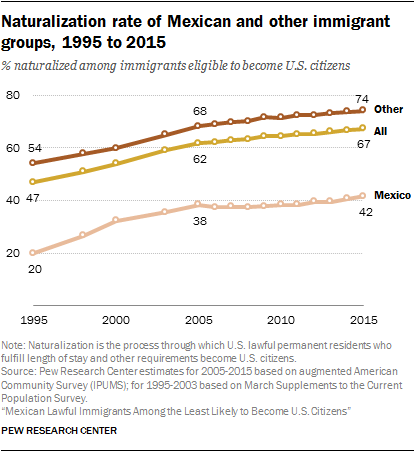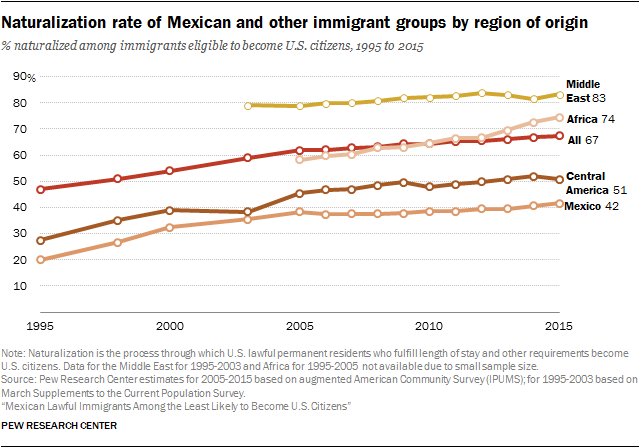
In 2015, 67% of lawful permanent residents eligible to become U.S. citizens had done so, the highest level in two decades and a 20-percentage-point increase since 1995.
The population of naturalized U.S. citizens reached 19.8 million in 2015, a historic high that reflects both an increase in the population of eligible immigrants and an increased likelihood that those who are eligible to apply for citizenship actually do so.

The total number of lawful immigrants – naturalized U.S. citizens and lawful permanent residents – more than doubled since the 1970s, reaching 31.6 million in 2015. And since 2005, the number of lawful permanent resident admissions7 alone has exceeded 1 million annually, with the exception of 2013.
In 2015, a majority (62%) of all the lawful immigrants living in the country had already become naturalized citizens. The rest – 11.9 million – are green-card holders who could eventually naturalize and become U.S. citizens.
In 2015, naturalized citizens accounted for 44% of the nearly 45 million total immigrants living in the U.S., up from 33% of the 33 million immigrants in 2000. (Total immigrants include naturalized citizens, lawful permanent residents, unauthorized immigrants and temporary lawful residents.) During this period, the share of lawful permanent residents among the foreign-born population shrank from 36% in 2000 to 27% in 2015.
Mexican lawful immigrants have one of the lowest naturalization rates

Among the 9.3 million immigrants eligible to apply for U.S. citizenship in 2015, 3.5 million were from Mexico. That made Mexican immigrants the single largest origin group among those eligible to naturalize, accounting for more than a third of the group.
The naturalization rate among eligible Mexican immigrants has varied over time. In 1995, 20% of then-eligible-to-naturalize Mexicans had done so, compared with a naturalization rate of 54% among non-Mexican immigrants eligible to naturalize – a gap of 34 percentage points. However, in the late 1990s, the Mexican naturalization rate rose more sharply than it did among non-Mexicans overall. As a result, the gap fell to 27 percentage points in 2000 – a record low. From 2005 to 2010, the Mexican naturalization rate had again grown more slowly than it had for other immigrants. From 2011 to 2015, the rate of naturalization for Mexicans grew faster than it did for other immigrants. By 2015, while the Mexican naturalization rate had risen to 42%, for non-Mexicans it had risen to 74% in the same year, leading to a 32-percentage-point gap.
The lower naturalization rate among Mexican immigrants may be influenced by multiple factors. First, Mexican immigrants may maintain closer ties to Mexico because of its proximity to the U.S. and might return home at some point, which would reduce their interest in applying for citizenship. Second, there are personal and administrative barriers that make applying for citizenship difficult for some immigrants, such as a lack of English proficiency. Only about one-fourth (26%) of Mexican immigrants eligible to naturalize are proficient in English, compared with about half (51%) of lawful immigrants from other countries of origin. Also, the cost of naturalization is a possible barrier for some applicants. Overall, lawful Mexican immigrants have lower family incomes than lawful immigrants of other origins.8 In addition, Mexican immigrants may not be aware that they can hold both U.S. and Mexican citizenship at the same time. (Prior to 1998, Mexico did not allow its citizens to hold dual citizenship, though this has since changed.) A Pew Research Center survey of Mexican immigrants in 2012 showed 29% were not aware this was possible. Also, some lawful immigrants might perceive that citizenship awards few additional benefits to their lawful permanent resident status.





